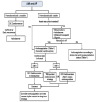Impact of Atrial Fibrillation On Cardiovascular Mortality in the Setting of Myocardial Infarction
- PMID: 28496798
- PMCID: PMC5153162
- DOI: 10.4022/jafib.722
Impact of Atrial Fibrillation On Cardiovascular Mortality in the Setting of Myocardial Infarction
Abstract
Atrial fibrillation (AF) commonly occurs in patient with acute myocardial infarction (AMI). Potential triggers for AF development in this setting includes reduced left ventricular function, advanced diastolic dysfunction and mitral regurgitation leading to elevated left atrial pressures and atrial stretch. Other triggering mechanisms include inflammation and atrial ischemia. Multiple studies have shown that AF in patients with is associated with increased mortality. However, whether AF is a risk marker or a causal mediator of death remains controversial. There is relative dearth of data with regard to optimal management of AF in the setting of acute coronary syndromes. Patients with AMI who develop AF are at increased risk of stroke. However, the issue of the most appropriate antithrombotic regimens is complex given the need to balance stroke prevention against recurrent coronary events or stent thrombosis and the risk of bleeding. Presently, 'triple therapy' consisting of dual antiplatelet agents plus oral anticoagulants for 3-6 months or longer has been recommended for patients at moderate-high risk of stroke. Atrial fibrillation (AF), the most common sustained arrhythmia seen in clinical practice, often coincides with acute myocardial infarction (AMI), with a reported incidence ranging between 7% and 21%.[1] The development of atrial fibrillation in the acute phase of AMI may aggravate ischemia and heart failure, lead to clinical instability and adversely affect outcome. In the following we will review the pathophysiology, clinical characteristics and importance, and management of AF occurring in the setting of AMI.
Figures
Similar articles
-
Impact of known or new-onset atrial fibrillation on 2-year cardiovascular event rate in patients with acute coronary syndromes: results from the prospective EPICOR Registry.Eur Heart J Acute Cardiovasc Care. 2019 Mar;8(2):121-129. doi: 10.1177/2048872618769057. Epub 2018 Apr 3. Eur Heart J Acute Cardiovasc Care. 2019. PMID: 29611427
-
Atrial fibrillation in patients hospitalized with acute myocardial infarction: analysis of the china acute myocardial infarction (CAMI) registry.BMC Cardiovasc Disord. 2017 Jan 4;17(1):2. doi: 10.1186/s12872-016-0442-9. BMC Cardiovasc Disord. 2017. PMID: 28052755 Free PMC article.
-
Effect of Procedure and Coronary Lesion Characteristics on Clinical Outcomes Among Atrial Fibrillation Patients Undergoing Percutaneous Coronary Intervention: Insights From the PIONEER AF-PCI Trial.JACC Cardiovasc Interv. 2018 Apr 9;11(7):626-634. doi: 10.1016/j.jcin.2017.11.009. Epub 2018 Mar 14. JACC Cardiovasc Interv. 2018. PMID: 29550085 Clinical Trial.
-
Patients with atrial fibrillation and coronary artery disease - Double trouble.Adv Med Sci. 2018 Mar;63(1):30-35. doi: 10.1016/j.advms.2017.06.005. Epub 2017 Aug 14. Adv Med Sci. 2018. PMID: 28818746 Review.
-
Antithrombotic therapy in patients with non-valvular atrial fibrillation undergoing percutaneous coronary intervention: should we change our practice after the PIONEER AF-PCI and RE-DUAL PCI trials?Clin Res Cardiol. 2018 Jul;107(7):533-538. doi: 10.1007/s00392-018-1242-2. Epub 2018 Apr 20. Clin Res Cardiol. 2018. PMID: 29679144 Review.
References
-
- Schmitt Joern, Duray Gabor, Gersh Bernard J, Hohnloser Stefan H. Atrial fibrillation in acute myocardial infarction: a systematic review of the incidence, clinical features and prognostic implications. Eur. Heart J. 2009 May;30 (9):1038–45. - PubMed
-
- Schmitt Joern, Duray Gabor, Gersh Bernard J, Hohnloser Stefan H. Atrial fibrillation in acute myocardial infarction: a systematic review of the incidence, clinical features and prognostic implications. Eur. Heart J. 2009 May;30 (9):1038–45. - PubMed
-
- Aronson Doron, Boulos Monther, Suleiman Abeer, Bidoosi Salma, Agmon Yoram, Kapeliovich Michael, Beyar Rafael, Markiewicz Walter, Hammerman Haim, Suleiman Mahmoud. Relation of C-reactive protein and new-onset atrial fibrillation in patients with acute myocardial infarction. Am. J. Cardiol. 2007 Sep 01;100 (5):753–7. - PubMed
-
- Nagahama Y, Sugiura T, Takehana K, Hatada K, Inada M, Iwasaka T. The role of infarction-associated pericarditis on the occurrence of atrial fibrillation. Eur. Heart J. 1998 Feb;19 (2):287–92. - PubMed
-
- Sinno Hani, Derakhchan Katayoun, Libersan Danielle, Merhi Yahye, Leung Tack Ki, Nattel Stanley. Atrial ischemia promotes atrial fibrillation in dogs. Circulation. 2003 Apr 15;107 (14):1930–6. - PubMed
Publication types
LinkOut - more resources
Full Text Sources


